Foundation of Information Systems: Augmented Reality in Business Use
VerifiedAdded on 2023/03/31
|8
|1873
|59
Report
AI Summary
This report provides an overview of augmented reality (AR) technology, defining it as an interactive experience that enhances the real world through computer-generated perceptual information. It details the workings of AR, including the use of cameras, sensors, processors, and projection techniques like S.L.A.M. (Simultaneous Localization and Mapping). The report highlights AR's requirements in providing real-time experiences, training simulations, and its applications across gaming, retail, real estate, tourism, medical, and military sectors. It also discusses the strengths of AR, such as its interactive nature and diagnostic capabilities, along with weaknesses like high costs and privacy concerns. Furthermore, the report addresses ethical issues, including mental and social side effects and data privacy, before concluding that AR is the future of many industries but requires careful consideration of its ethical implications. Desklib offers this report and many other solved assignments for students.
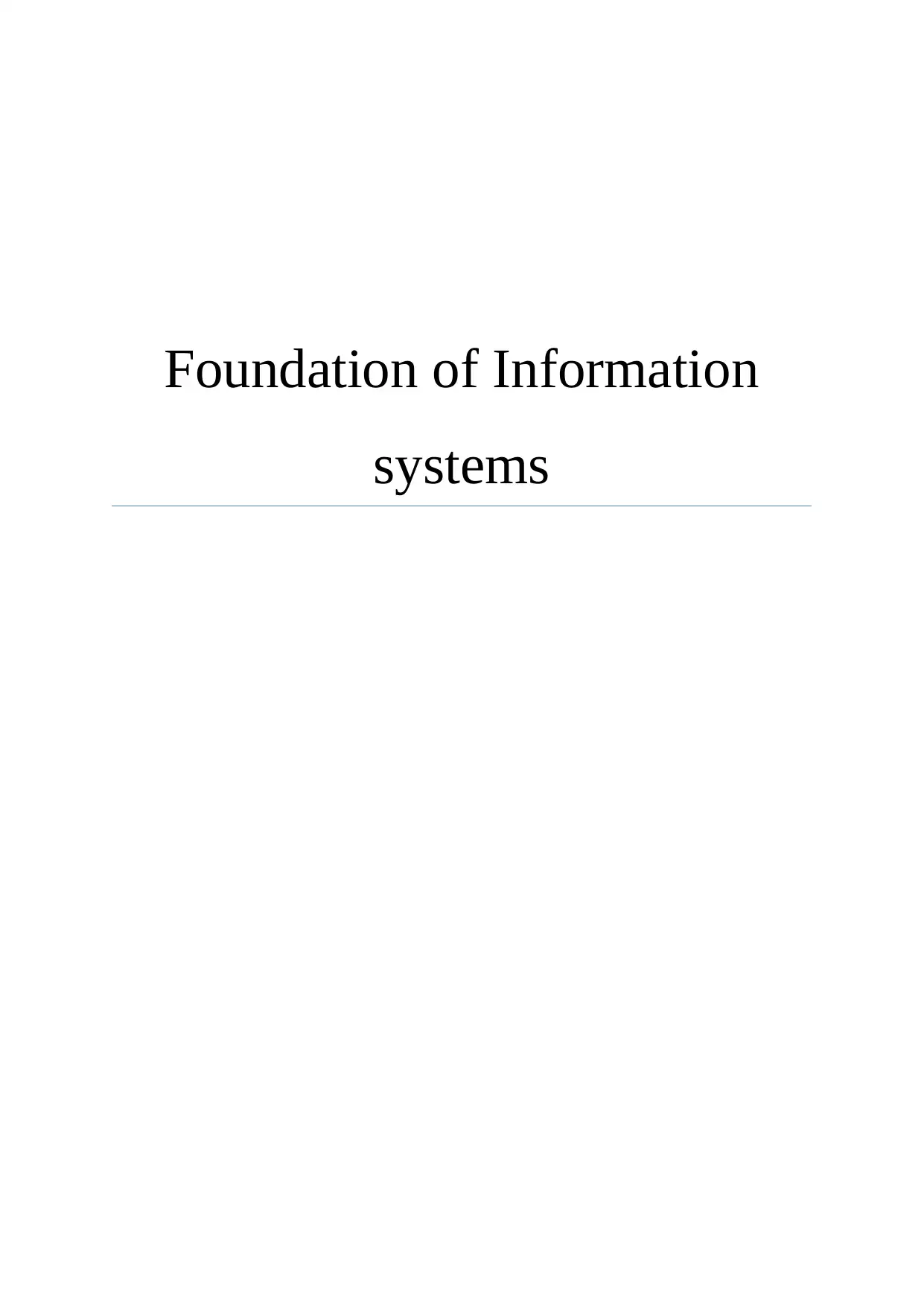
Foundation of Information
systems
systems
Paraphrase This Document
Need a fresh take? Get an instant paraphrase of this document with our AI Paraphraser
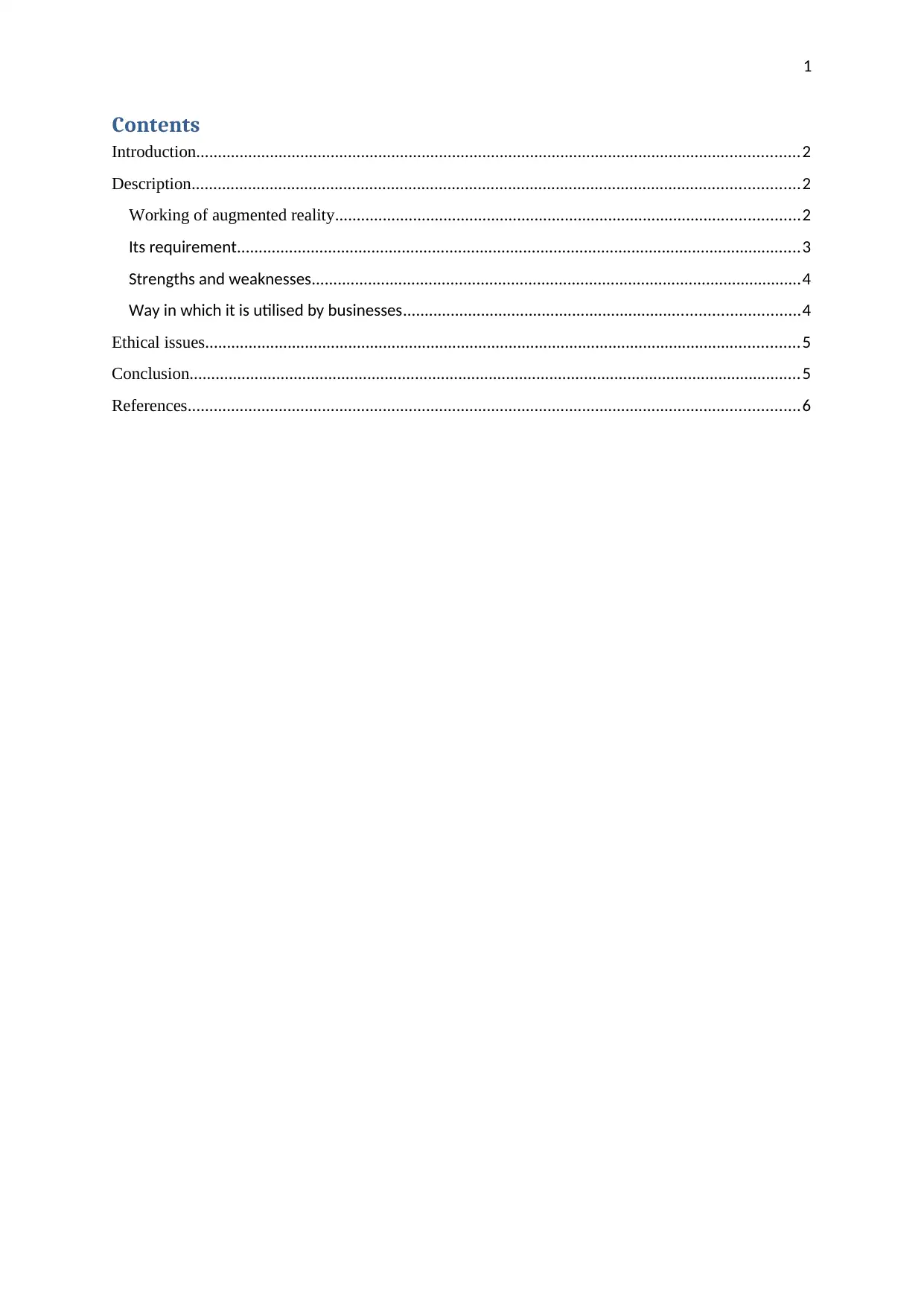
1
Contents
Introduction...........................................................................................................................................2
Description............................................................................................................................................2
Working of augmented reality...........................................................................................................2
Its requirement..................................................................................................................................3
Strengths and weaknesses.................................................................................................................4
Way in which it is utilised by businesses...........................................................................................4
Ethical issues.........................................................................................................................................5
Conclusion.............................................................................................................................................5
References.............................................................................................................................................6
Contents
Introduction...........................................................................................................................................2
Description............................................................................................................................................2
Working of augmented reality...........................................................................................................2
Its requirement..................................................................................................................................3
Strengths and weaknesses.................................................................................................................4
Way in which it is utilised by businesses...........................................................................................4
Ethical issues.........................................................................................................................................5
Conclusion.............................................................................................................................................5
References.............................................................................................................................................6
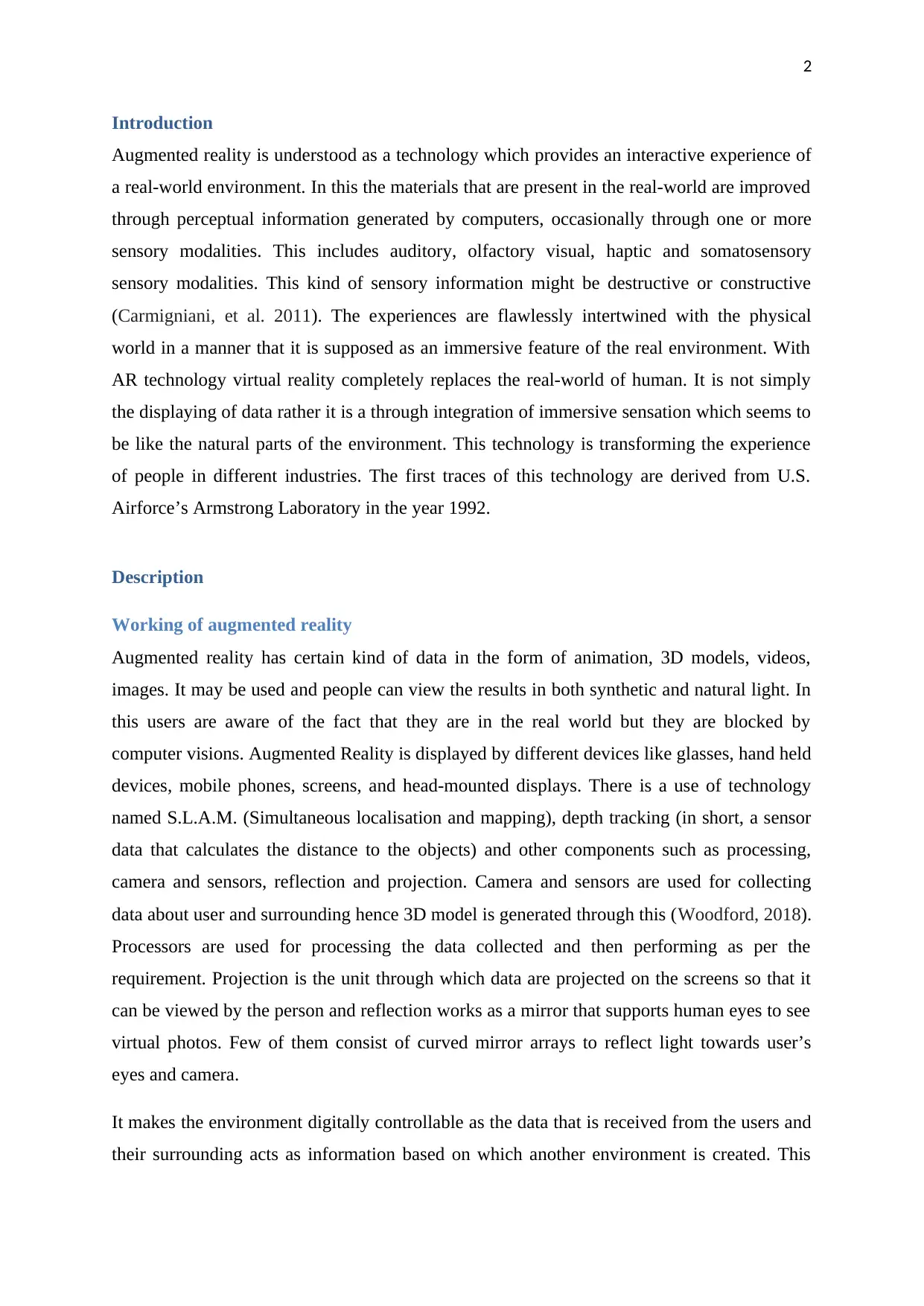
2
Introduction
Augmented reality is understood as a technology which provides an interactive experience of
a real-world environment. In this the materials that are present in the real-world are improved
through perceptual information generated by computers, occasionally through one or more
sensory modalities. This includes auditory, olfactory visual, haptic and somatosensory
sensory modalities. This kind of sensory information might be destructive or constructive
(Carmigniani, et al. 2011). The experiences are flawlessly intertwined with the physical
world in a manner that it is supposed as an immersive feature of the real environment. With
AR technology virtual reality completely replaces the real-world of human. It is not simply
the displaying of data rather it is a through integration of immersive sensation which seems to
be like the natural parts of the environment. This technology is transforming the experience
of people in different industries. The first traces of this technology are derived from U.S.
Airforce’s Armstrong Laboratory in the year 1992.
Description
Working of augmented reality
Augmented reality has certain kind of data in the form of animation, 3D models, videos,
images. It may be used and people can view the results in both synthetic and natural light. In
this users are aware of the fact that they are in the real world but they are blocked by
computer visions. Augmented Reality is displayed by different devices like glasses, hand held
devices, mobile phones, screens, and head-mounted displays. There is a use of technology
named S.L.A.M. (Simultaneous localisation and mapping), depth tracking (in short, a sensor
data that calculates the distance to the objects) and other components such as processing,
camera and sensors, reflection and projection. Camera and sensors are used for collecting
data about user and surrounding hence 3D model is generated through this (Woodford, 2018).
Processors are used for processing the data collected and then performing as per the
requirement. Projection is the unit through which data are projected on the screens so that it
can be viewed by the person and reflection works as a mirror that supports human eyes to see
virtual photos. Few of them consist of curved mirror arrays to reflect light towards user’s
eyes and camera.
It makes the environment digitally controllable as the data that is received from the users and
their surrounding acts as information based on which another environment is created. This
Introduction
Augmented reality is understood as a technology which provides an interactive experience of
a real-world environment. In this the materials that are present in the real-world are improved
through perceptual information generated by computers, occasionally through one or more
sensory modalities. This includes auditory, olfactory visual, haptic and somatosensory
sensory modalities. This kind of sensory information might be destructive or constructive
(Carmigniani, et al. 2011). The experiences are flawlessly intertwined with the physical
world in a manner that it is supposed as an immersive feature of the real environment. With
AR technology virtual reality completely replaces the real-world of human. It is not simply
the displaying of data rather it is a through integration of immersive sensation which seems to
be like the natural parts of the environment. This technology is transforming the experience
of people in different industries. The first traces of this technology are derived from U.S.
Airforce’s Armstrong Laboratory in the year 1992.
Description
Working of augmented reality
Augmented reality has certain kind of data in the form of animation, 3D models, videos,
images. It may be used and people can view the results in both synthetic and natural light. In
this users are aware of the fact that they are in the real world but they are blocked by
computer visions. Augmented Reality is displayed by different devices like glasses, hand held
devices, mobile phones, screens, and head-mounted displays. There is a use of technology
named S.L.A.M. (Simultaneous localisation and mapping), depth tracking (in short, a sensor
data that calculates the distance to the objects) and other components such as processing,
camera and sensors, reflection and projection. Camera and sensors are used for collecting
data about user and surrounding hence 3D model is generated through this (Woodford, 2018).
Processors are used for processing the data collected and then performing as per the
requirement. Projection is the unit through which data are projected on the screens so that it
can be viewed by the person and reflection works as a mirror that supports human eyes to see
virtual photos. Few of them consist of curved mirror arrays to reflect light towards user’s
eyes and camera.
It makes the environment digitally controllable as the data that is received from the users and
their surrounding acts as information based on which another environment is created. This
⊘ This is a preview!⊘
Do you want full access?
Subscribe today to unlock all pages.

Trusted by 1+ million students worldwide
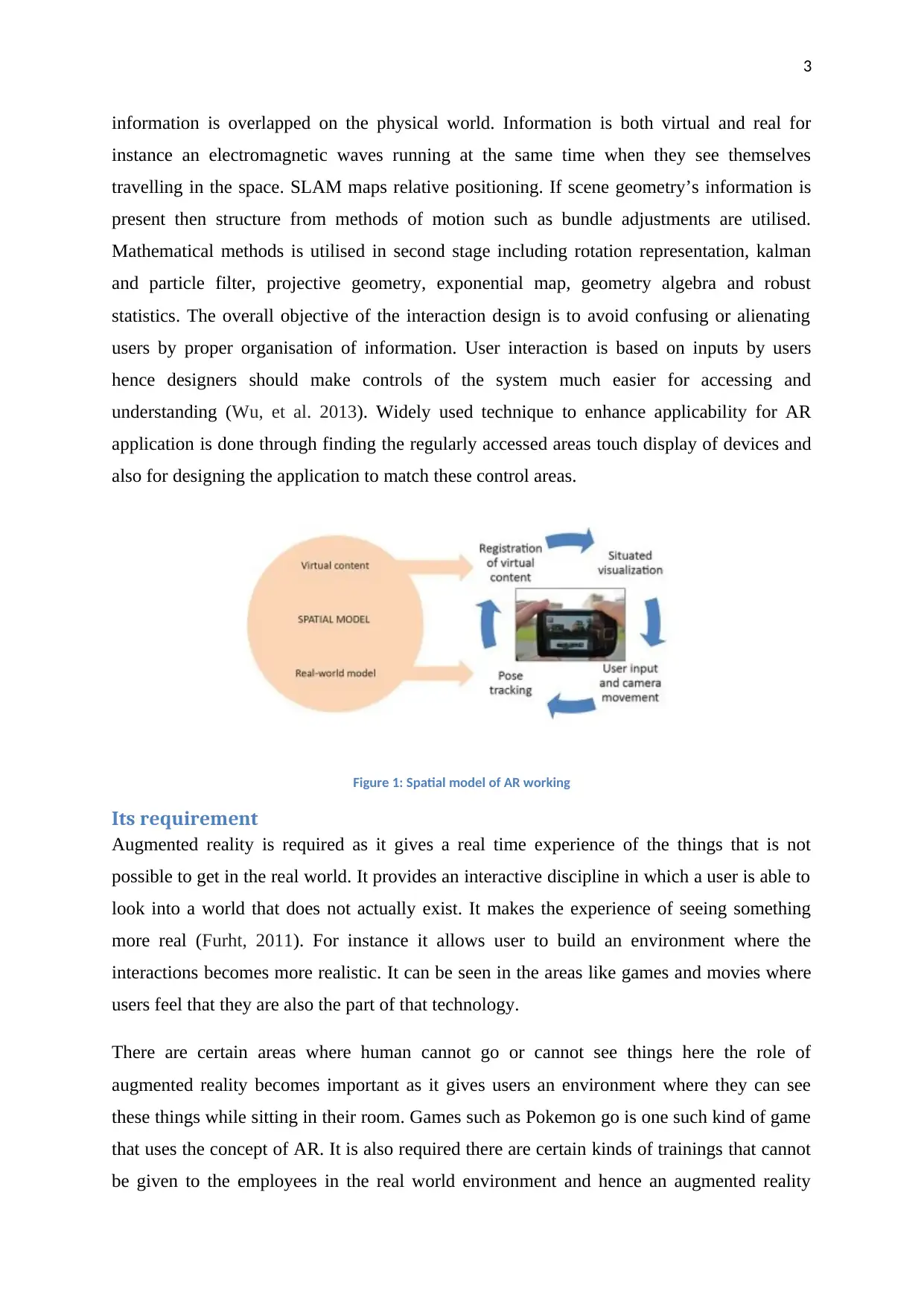
3
information is overlapped on the physical world. Information is both virtual and real for
instance an electromagnetic waves running at the same time when they see themselves
travelling in the space. SLAM maps relative positioning. If scene geometry’s information is
present then structure from methods of motion such as bundle adjustments are utilised.
Mathematical methods is utilised in second stage including rotation representation, kalman
and particle filter, projective geometry, exponential map, geometry algebra and robust
statistics. The overall objective of the interaction design is to avoid confusing or alienating
users by proper organisation of information. User interaction is based on inputs by users
hence designers should make controls of the system much easier for accessing and
understanding (Wu, et al. 2013). Widely used technique to enhance applicability for AR
application is done through finding the regularly accessed areas touch display of devices and
also for designing the application to match these control areas.
Figure 1: Spatial model of AR working
Its requirement
Augmented reality is required as it gives a real time experience of the things that is not
possible to get in the real world. It provides an interactive discipline in which a user is able to
look into a world that does not actually exist. It makes the experience of seeing something
more real (Furht, 2011). For instance it allows user to build an environment where the
interactions becomes more realistic. It can be seen in the areas like games and movies where
users feel that they are also the part of that technology.
There are certain areas where human cannot go or cannot see things here the role of
augmented reality becomes important as it gives users an environment where they can see
these things while sitting in their room. Games such as Pokemon go is one such kind of game
that uses the concept of AR. It is also required there are certain kinds of trainings that cannot
be given to the employees in the real world environment and hence an augmented reality
information is overlapped on the physical world. Information is both virtual and real for
instance an electromagnetic waves running at the same time when they see themselves
travelling in the space. SLAM maps relative positioning. If scene geometry’s information is
present then structure from methods of motion such as bundle adjustments are utilised.
Mathematical methods is utilised in second stage including rotation representation, kalman
and particle filter, projective geometry, exponential map, geometry algebra and robust
statistics. The overall objective of the interaction design is to avoid confusing or alienating
users by proper organisation of information. User interaction is based on inputs by users
hence designers should make controls of the system much easier for accessing and
understanding (Wu, et al. 2013). Widely used technique to enhance applicability for AR
application is done through finding the regularly accessed areas touch display of devices and
also for designing the application to match these control areas.
Figure 1: Spatial model of AR working
Its requirement
Augmented reality is required as it gives a real time experience of the things that is not
possible to get in the real world. It provides an interactive discipline in which a user is able to
look into a world that does not actually exist. It makes the experience of seeing something
more real (Furht, 2011). For instance it allows user to build an environment where the
interactions becomes more realistic. It can be seen in the areas like games and movies where
users feel that they are also the part of that technology.
There are certain areas where human cannot go or cannot see things here the role of
augmented reality becomes important as it gives users an environment where they can see
these things while sitting in their room. Games such as Pokemon go is one such kind of game
that uses the concept of AR. It is also required there are certain kinds of trainings that cannot
be given to the employees in the real world environment and hence an augmented reality
Paraphrase This Document
Need a fresh take? Get an instant paraphrase of this document with our AI Paraphraser
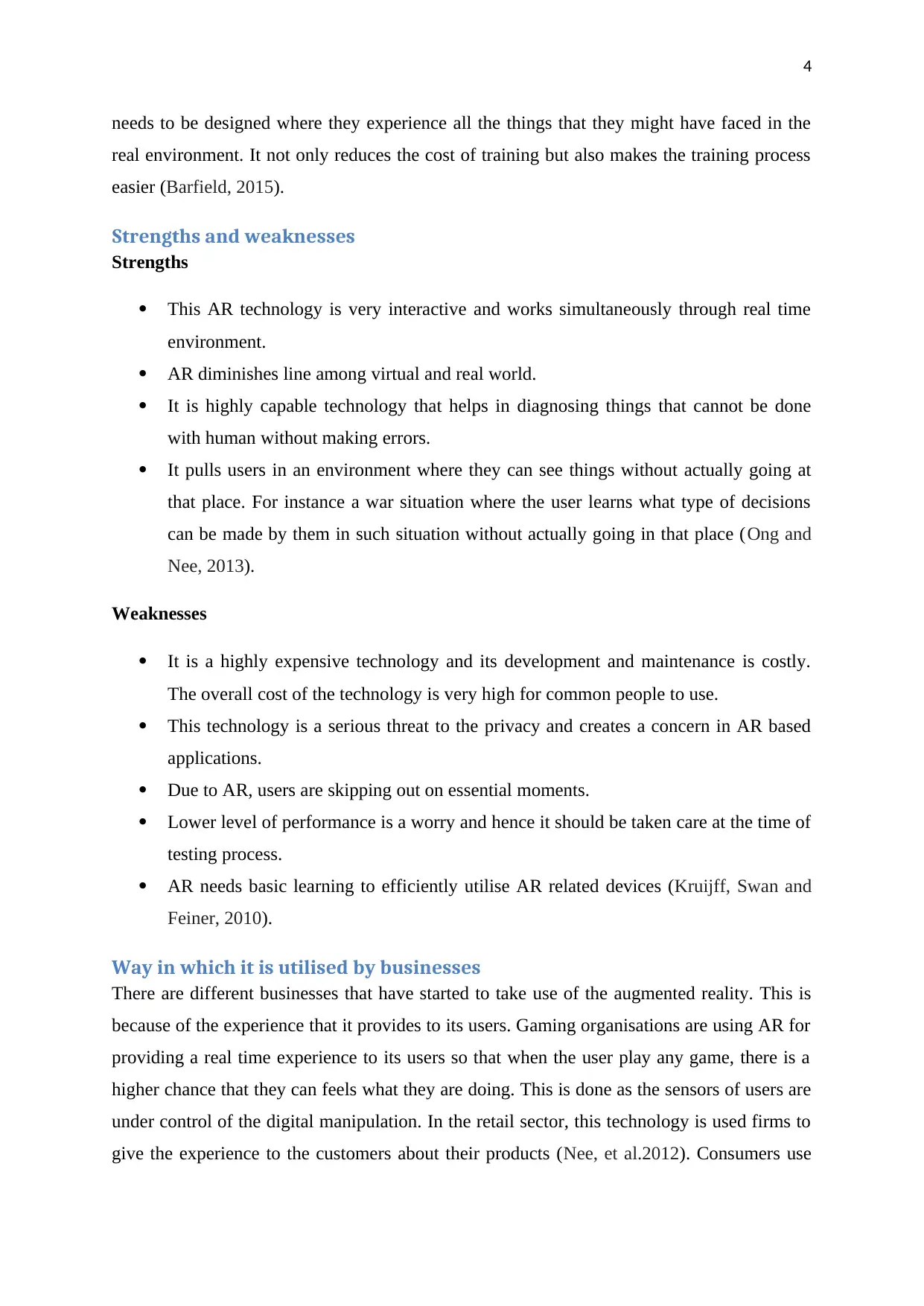
4
needs to be designed where they experience all the things that they might have faced in the
real environment. It not only reduces the cost of training but also makes the training process
easier (Barfield, 2015).
Strengths and weaknesses
Strengths
This AR technology is very interactive and works simultaneously through real time
environment.
AR diminishes line among virtual and real world.
It is highly capable technology that helps in diagnosing things that cannot be done
with human without making errors.
It pulls users in an environment where they can see things without actually going at
that place. For instance a war situation where the user learns what type of decisions
can be made by them in such situation without actually going in that place (Ong and
Nee, 2013).
Weaknesses
It is a highly expensive technology and its development and maintenance is costly.
The overall cost of the technology is very high for common people to use.
This technology is a serious threat to the privacy and creates a concern in AR based
applications.
Due to AR, users are skipping out on essential moments.
Lower level of performance is a worry and hence it should be taken care at the time of
testing process.
AR needs basic learning to efficiently utilise AR related devices (Kruijff, Swan and
Feiner, 2010).
Way in which it is utilised by businesses
There are different businesses that have started to take use of the augmented reality. This is
because of the experience that it provides to its users. Gaming organisations are using AR for
providing a real time experience to its users so that when the user play any game, there is a
higher chance that they can feels what they are doing. This is done as the sensors of users are
under control of the digital manipulation. In the retail sector, this technology is used firms to
give the experience to the customers about their products (Nee, et al.2012). Consumers use
needs to be designed where they experience all the things that they might have faced in the
real environment. It not only reduces the cost of training but also makes the training process
easier (Barfield, 2015).
Strengths and weaknesses
Strengths
This AR technology is very interactive and works simultaneously through real time
environment.
AR diminishes line among virtual and real world.
It is highly capable technology that helps in diagnosing things that cannot be done
with human without making errors.
It pulls users in an environment where they can see things without actually going at
that place. For instance a war situation where the user learns what type of decisions
can be made by them in such situation without actually going in that place (Ong and
Nee, 2013).
Weaknesses
It is a highly expensive technology and its development and maintenance is costly.
The overall cost of the technology is very high for common people to use.
This technology is a serious threat to the privacy and creates a concern in AR based
applications.
Due to AR, users are skipping out on essential moments.
Lower level of performance is a worry and hence it should be taken care at the time of
testing process.
AR needs basic learning to efficiently utilise AR related devices (Kruijff, Swan and
Feiner, 2010).
Way in which it is utilised by businesses
There are different businesses that have started to take use of the augmented reality. This is
because of the experience that it provides to its users. Gaming organisations are using AR for
providing a real time experience to its users so that when the user play any game, there is a
higher chance that they can feels what they are doing. This is done as the sensors of users are
under control of the digital manipulation. In the retail sector, this technology is used firms to
give the experience to the customers about their products (Nee, et al.2012). Consumers use
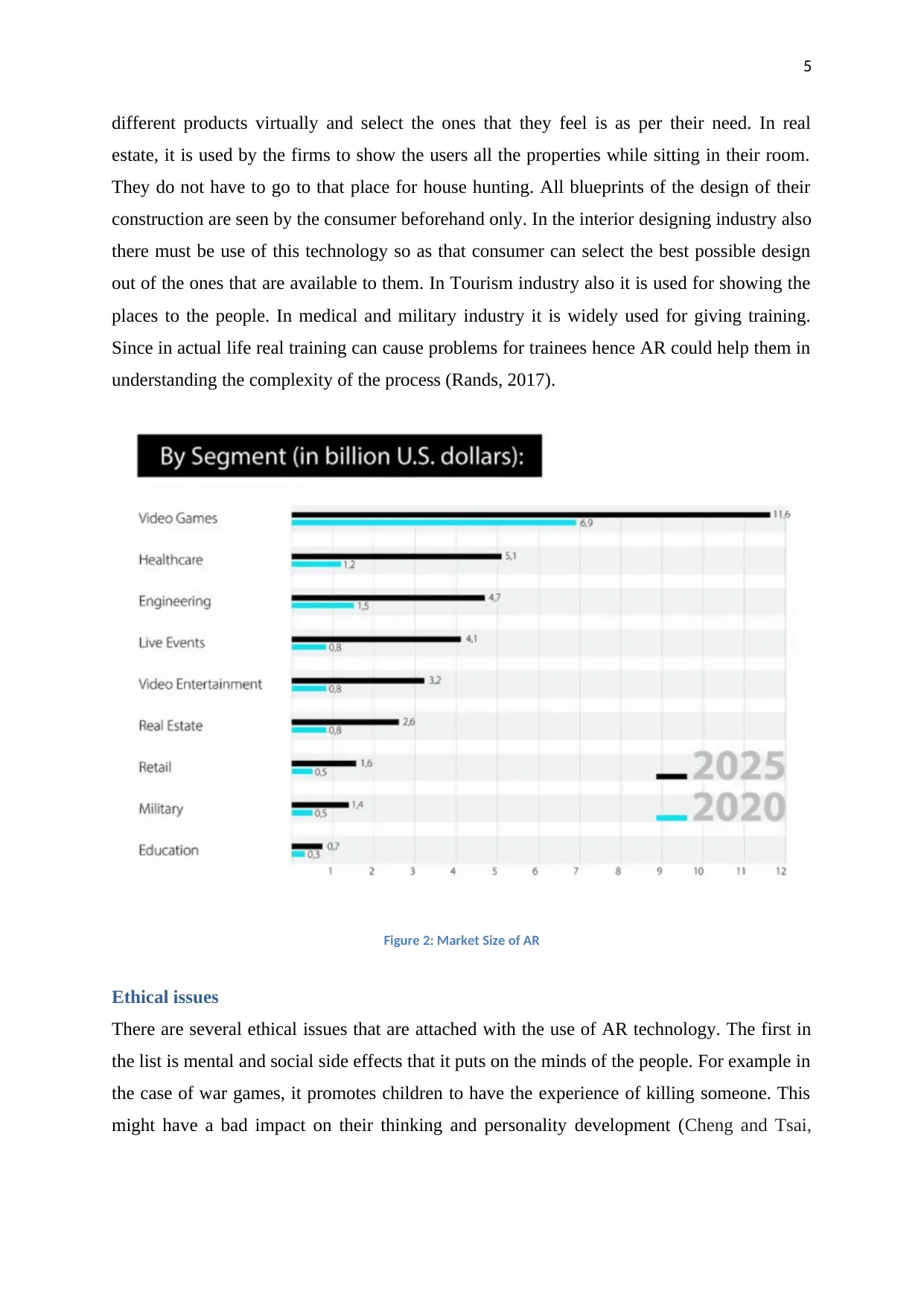
5
different products virtually and select the ones that they feel is as per their need. In real
estate, it is used by the firms to show the users all the properties while sitting in their room.
They do not have to go to that place for house hunting. All blueprints of the design of their
construction are seen by the consumer beforehand only. In the interior designing industry also
there must be use of this technology so as that consumer can select the best possible design
out of the ones that are available to them. In Tourism industry also it is used for showing the
places to the people. In medical and military industry it is widely used for giving training.
Since in actual life real training can cause problems for trainees hence AR could help them in
understanding the complexity of the process (Rands, 2017).
Figure 2: Market Size of AR
Ethical issues
There are several ethical issues that are attached with the use of AR technology. The first in
the list is mental and social side effects that it puts on the minds of the people. For example in
the case of war games, it promotes children to have the experience of killing someone. This
might have a bad impact on their thinking and personality development (Cheng and Tsai,
different products virtually and select the ones that they feel is as per their need. In real
estate, it is used by the firms to show the users all the properties while sitting in their room.
They do not have to go to that place for house hunting. All blueprints of the design of their
construction are seen by the consumer beforehand only. In the interior designing industry also
there must be use of this technology so as that consumer can select the best possible design
out of the ones that are available to them. In Tourism industry also it is used for showing the
places to the people. In medical and military industry it is widely used for giving training.
Since in actual life real training can cause problems for trainees hence AR could help them in
understanding the complexity of the process (Rands, 2017).
Figure 2: Market Size of AR
Ethical issues
There are several ethical issues that are attached with the use of AR technology. The first in
the list is mental and social side effects that it puts on the minds of the people. For example in
the case of war games, it promotes children to have the experience of killing someone. This
might have a bad impact on their thinking and personality development (Cheng and Tsai,
⊘ This is a preview!⊘
Do you want full access?
Subscribe today to unlock all pages.

Trusted by 1+ million students worldwide
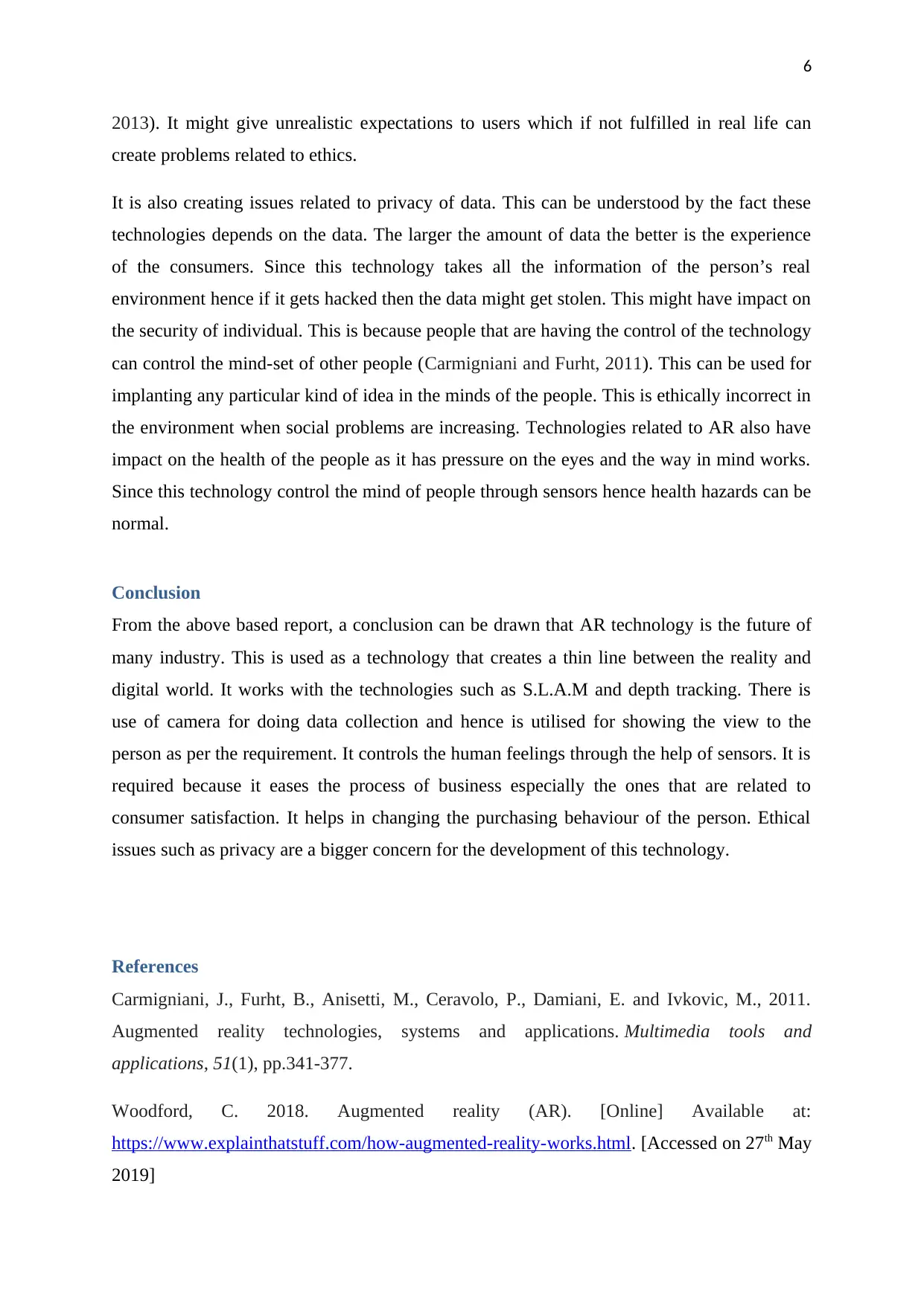
6
2013). It might give unrealistic expectations to users which if not fulfilled in real life can
create problems related to ethics.
It is also creating issues related to privacy of data. This can be understood by the fact these
technologies depends on the data. The larger the amount of data the better is the experience
of the consumers. Since this technology takes all the information of the person’s real
environment hence if it gets hacked then the data might get stolen. This might have impact on
the security of individual. This is because people that are having the control of the technology
can control the mind-set of other people (Carmigniani and Furht, 2011). This can be used for
implanting any particular kind of idea in the minds of the people. This is ethically incorrect in
the environment when social problems are increasing. Technologies related to AR also have
impact on the health of the people as it has pressure on the eyes and the way in mind works.
Since this technology control the mind of people through sensors hence health hazards can be
normal.
Conclusion
From the above based report, a conclusion can be drawn that AR technology is the future of
many industry. This is used as a technology that creates a thin line between the reality and
digital world. It works with the technologies such as S.L.A.M and depth tracking. There is
use of camera for doing data collection and hence is utilised for showing the view to the
person as per the requirement. It controls the human feelings through the help of sensors. It is
required because it eases the process of business especially the ones that are related to
consumer satisfaction. It helps in changing the purchasing behaviour of the person. Ethical
issues such as privacy are a bigger concern for the development of this technology.
References
Carmigniani, J., Furht, B., Anisetti, M., Ceravolo, P., Damiani, E. and Ivkovic, M., 2011.
Augmented reality technologies, systems and applications. Multimedia tools and
applications, 51(1), pp.341-377.
Woodford, C. 2018. Augmented reality (AR). [Online] Available at:
https://www.explainthatstuff.com/how-augmented-reality-works.html. [Accessed on 27th May
2019]
2013). It might give unrealistic expectations to users which if not fulfilled in real life can
create problems related to ethics.
It is also creating issues related to privacy of data. This can be understood by the fact these
technologies depends on the data. The larger the amount of data the better is the experience
of the consumers. Since this technology takes all the information of the person’s real
environment hence if it gets hacked then the data might get stolen. This might have impact on
the security of individual. This is because people that are having the control of the technology
can control the mind-set of other people (Carmigniani and Furht, 2011). This can be used for
implanting any particular kind of idea in the minds of the people. This is ethically incorrect in
the environment when social problems are increasing. Technologies related to AR also have
impact on the health of the people as it has pressure on the eyes and the way in mind works.
Since this technology control the mind of people through sensors hence health hazards can be
normal.
Conclusion
From the above based report, a conclusion can be drawn that AR technology is the future of
many industry. This is used as a technology that creates a thin line between the reality and
digital world. It works with the technologies such as S.L.A.M and depth tracking. There is
use of camera for doing data collection and hence is utilised for showing the view to the
person as per the requirement. It controls the human feelings through the help of sensors. It is
required because it eases the process of business especially the ones that are related to
consumer satisfaction. It helps in changing the purchasing behaviour of the person. Ethical
issues such as privacy are a bigger concern for the development of this technology.
References
Carmigniani, J., Furht, B., Anisetti, M., Ceravolo, P., Damiani, E. and Ivkovic, M., 2011.
Augmented reality technologies, systems and applications. Multimedia tools and
applications, 51(1), pp.341-377.
Woodford, C. 2018. Augmented reality (AR). [Online] Available at:
https://www.explainthatstuff.com/how-augmented-reality-works.html. [Accessed on 27th May
2019]
Paraphrase This Document
Need a fresh take? Get an instant paraphrase of this document with our AI Paraphraser
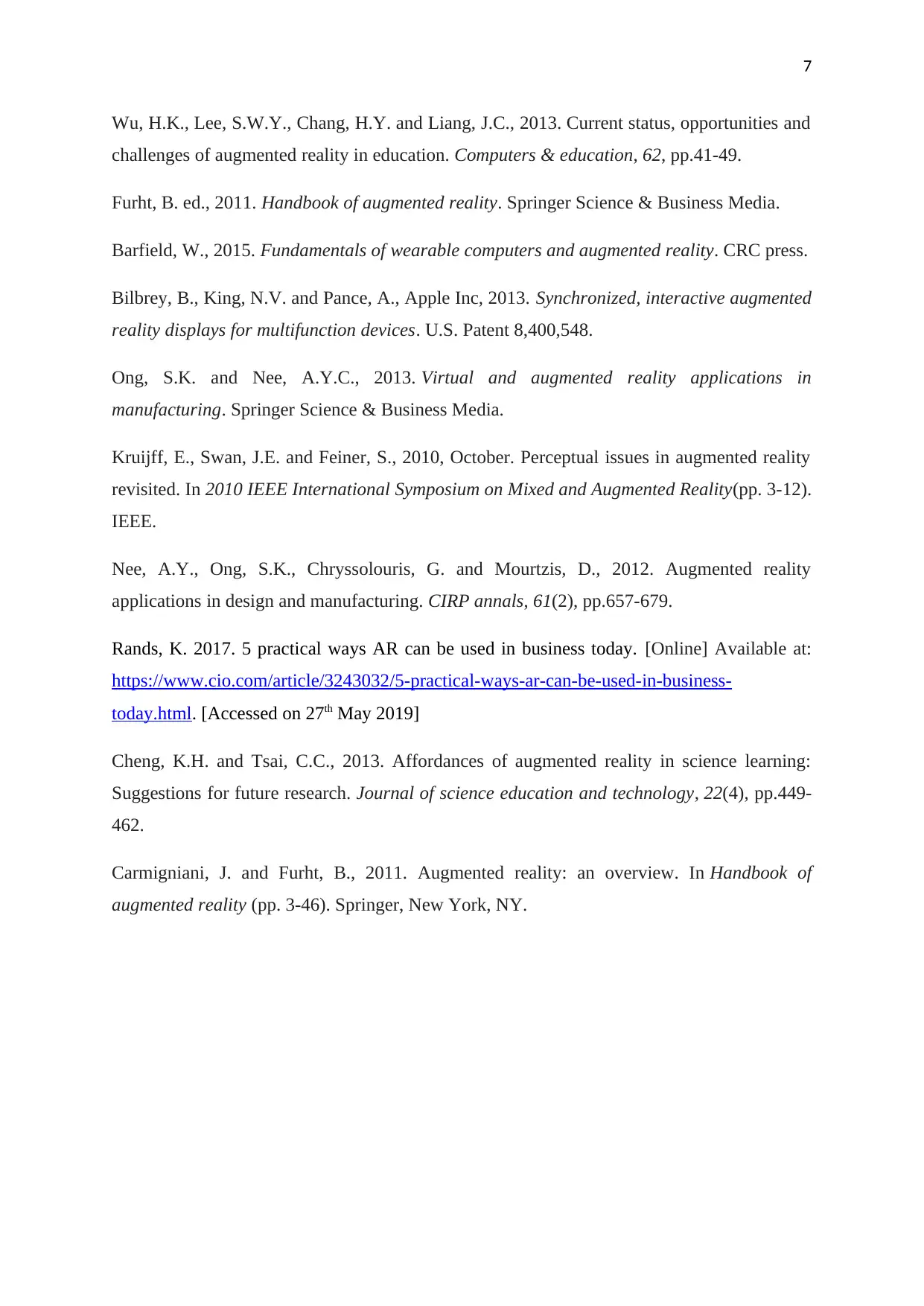
7
Wu, H.K., Lee, S.W.Y., Chang, H.Y. and Liang, J.C., 2013. Current status, opportunities and
challenges of augmented reality in education. Computers & education, 62, pp.41-49.
Furht, B. ed., 2011. Handbook of augmented reality. Springer Science & Business Media.
Barfield, W., 2015. Fundamentals of wearable computers and augmented reality. CRC press.
Bilbrey, B., King, N.V. and Pance, A., Apple Inc, 2013. Synchronized, interactive augmented
reality displays for multifunction devices. U.S. Patent 8,400,548.
Ong, S.K. and Nee, A.Y.C., 2013. Virtual and augmented reality applications in
manufacturing. Springer Science & Business Media.
Kruijff, E., Swan, J.E. and Feiner, S., 2010, October. Perceptual issues in augmented reality
revisited. In 2010 IEEE International Symposium on Mixed and Augmented Reality(pp. 3-12).
IEEE.
Nee, A.Y., Ong, S.K., Chryssolouris, G. and Mourtzis, D., 2012. Augmented reality
applications in design and manufacturing. CIRP annals, 61(2), pp.657-679.
Rands, K. 2017. 5 practical ways AR can be used in business today. [Online] Available at:
https://www.cio.com/article/3243032/5-practical-ways-ar-can-be-used-in-business-
today.html. [Accessed on 27th May 2019]
Cheng, K.H. and Tsai, C.C., 2013. Affordances of augmented reality in science learning:
Suggestions for future research. Journal of science education and technology, 22(4), pp.449-
462.
Carmigniani, J. and Furht, B., 2011. Augmented reality: an overview. In Handbook of
augmented reality (pp. 3-46). Springer, New York, NY.
Wu, H.K., Lee, S.W.Y., Chang, H.Y. and Liang, J.C., 2013. Current status, opportunities and
challenges of augmented reality in education. Computers & education, 62, pp.41-49.
Furht, B. ed., 2011. Handbook of augmented reality. Springer Science & Business Media.
Barfield, W., 2015. Fundamentals of wearable computers and augmented reality. CRC press.
Bilbrey, B., King, N.V. and Pance, A., Apple Inc, 2013. Synchronized, interactive augmented
reality displays for multifunction devices. U.S. Patent 8,400,548.
Ong, S.K. and Nee, A.Y.C., 2013. Virtual and augmented reality applications in
manufacturing. Springer Science & Business Media.
Kruijff, E., Swan, J.E. and Feiner, S., 2010, October. Perceptual issues in augmented reality
revisited. In 2010 IEEE International Symposium on Mixed and Augmented Reality(pp. 3-12).
IEEE.
Nee, A.Y., Ong, S.K., Chryssolouris, G. and Mourtzis, D., 2012. Augmented reality
applications in design and manufacturing. CIRP annals, 61(2), pp.657-679.
Rands, K. 2017. 5 practical ways AR can be used in business today. [Online] Available at:
https://www.cio.com/article/3243032/5-practical-ways-ar-can-be-used-in-business-
today.html. [Accessed on 27th May 2019]
Cheng, K.H. and Tsai, C.C., 2013. Affordances of augmented reality in science learning:
Suggestions for future research. Journal of science education and technology, 22(4), pp.449-
462.
Carmigniani, J. and Furht, B., 2011. Augmented reality: an overview. In Handbook of
augmented reality (pp. 3-46). Springer, New York, NY.
1 out of 8
Related Documents
Your All-in-One AI-Powered Toolkit for Academic Success.
+13062052269
info@desklib.com
Available 24*7 on WhatsApp / Email
![[object Object]](/_next/static/media/star-bottom.7253800d.svg)
Unlock your academic potential
Copyright © 2020–2025 A2Z Services. All Rights Reserved. Developed and managed by ZUCOL.





